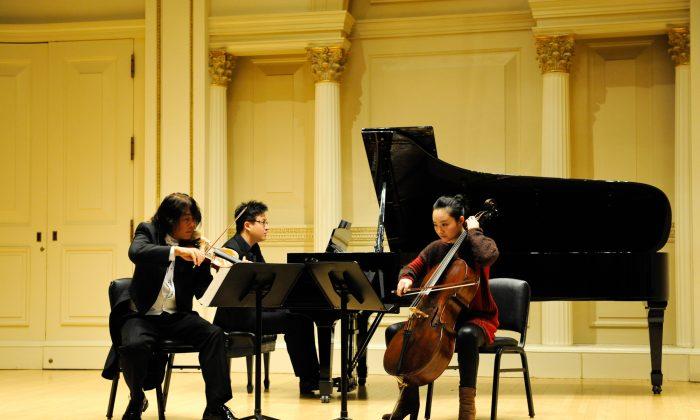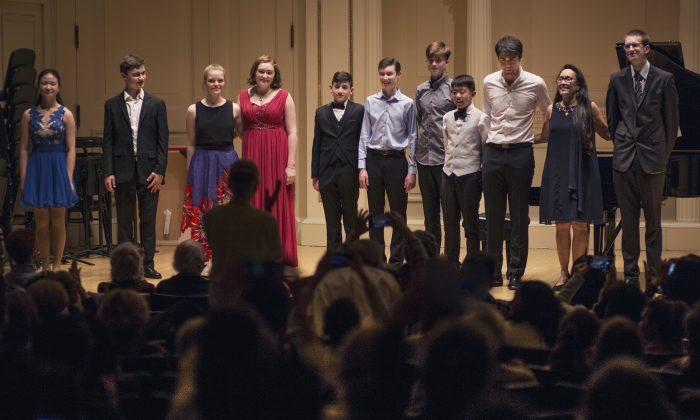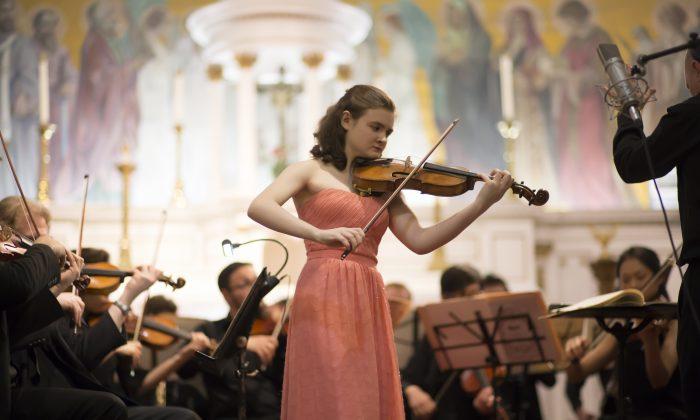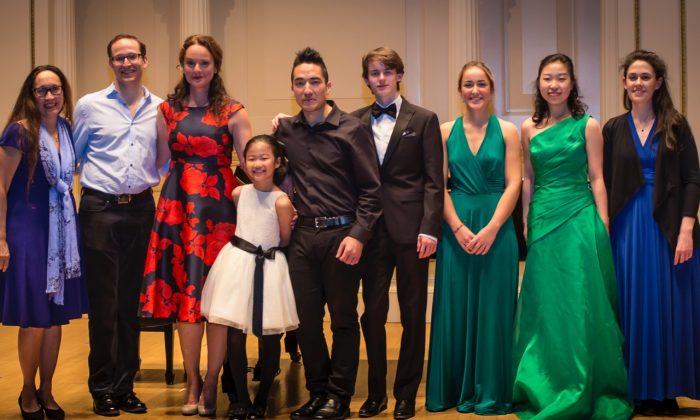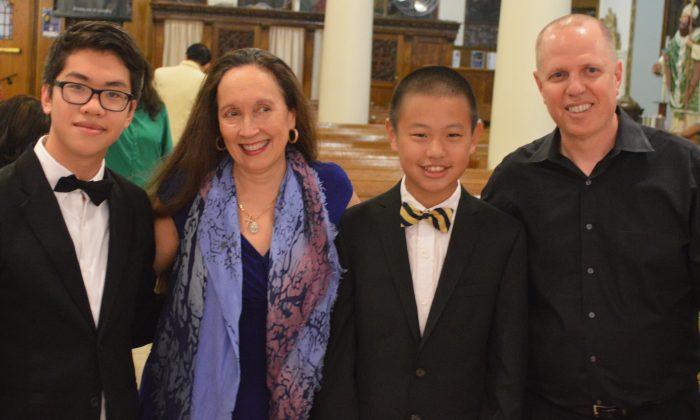NEW YORK—An infrequently heard impressionist masterpiece by Debussy for harp and string quintet was among the highlights of an engaging concert given at Carnegie Hall’s Weill Recital Hall on Sunday afternoon, Nov. 24.
Presented by the New York Concerti Sinfonietta and the Asian Cultural Center, the concert featured 14 soloists of varied ages making their “2013 International Shining Stars Debuts” at Carnegie Hall.
Dr. Julie Jordan, founder and artistic director of the New York Concerti Sinfonietta, is in her 28th year as a member of the piano faculty of The Juilliard School Evening Division.
The entire program comprised works by 14 different composers. Many of the performances at the sold-out concert were worthy of special notice.
Heavenly Harp
Debussy’s “Danses sacrée et profane” is a nine-minute gem for harp and string orchestra or, as it was performed on this occasion, for harp and string quintet. The first movement is celestial and reverential, while the second is secular or earthly.
Mélanie Genin is a singular harp virtuoso, in total command of her instrument. A native of France, she holds a master’s degree from the Paris Conservatoire, has studied at Juilliard with New York Philharmonic harpist Nancy Allen, and is currently enrolled in the Artist Diploma Program at the Manhattan School of Music, where she studies with Deborah Hoffman, principal harpist with the Metropolitan Opera.
It is said of Orpheus, the legendary Greek musician taught by Apollo, that his playing could charm the wild beasts and move the rocks and trees. Nonetheless, Orpheus could not have produced more beguiling sounds from his lyre than did Ms. Genin with her harp.
Ms. Genin’s playing was exquisitely sensitive, evidencing evanescently subtle tone colors. She manifested an enormous range of dynamics, with exemplary phrasing and accents. Her supporting string quintet sounded gorgeous.
It would be a treat to hear her in the companion work to Debussy’s “Danses”: Ravel’s “Introduction and Allegro” for harp, flute, clarinet, and string quartet.
Triumphant Trombone
Carlos Salzedo is generally considered to be one of the greatest harpists of all time. He composed a multitude of works for his instrument. However, this concert featured a work from his youth, written for the unlikely medium of trombone and piano—about as far away from the harp as it is possible to get.
Salzedo’s “Piece Concertante,” op. 27, opens with a lyrical melody that is clearly reminiscent of the slow movement of Saint-Saëns’s Cello Concerto no. 1. It was admirably performed by Kens Lui, a native of Hong Kong, who displayed a mellow tone and accurate intonation on his slide trombone throughout.
Mr. Lui graduated from the Interlochen Arts Academy and is pursuing a B.M. degree at the New England Conservatory.
Cantorial and Magyar Cellos
Ernest Bloch’s “Prayer,” the first of three sketches “From Jewish Life,” takes advantage of the cello’s baritonal range to convey a cantorial character. It is comparable to Bloch’s “Nigun” (“Prayer”) from “Baal Shem” for violin and piano, which has been transcribed for cello, and to Max Bruch’s “Kol Nidre,” another quasi-cantorial classic for cello.
As played by Ying-Jun Wei, Bloch’s “Prayer” made a haunting impression. Her eloquent and expressive performance had real “soul.” Ms. Wei, a graduate of the Royal Academy of Music, studied with the late Bernard Greenhouse, renowned cellist of the Beaux Arts Trio.
A second, contrasting cello piece was written by David Popper. Born in Prague, Popper was an influential cellist and composer who wrote voluminously for his instrument. His “Hungarian Rhapsody,” op. 68, which demands considerable virtuosity from the player, surprises the listener by quoting a theme from Liszt’s “Hungarian Rhapsody no. 12,” before concluding with another quote from the Liszt “Hungarian Rhapsody no. 6.”
On the other hand, Popper’s homage is understandable, since he married Sophie Menter, a pupil of Liszt, and spent the last two decades of his life teaching at the Budapest Conservatory.
It was given a spirited and appealing performance by eighth-grader Alexander Rohatyn. Alexander’s technique, although precocious, is not yet fully formed. It is still developing and has considerable potential. Alexander is studying at the Manhattan School of Music.
Four Persuasive Pianists
A number of pianists particularly merit mention: Xixi Zhou gave an impetuous, abandoned, all-stops-out performance of Nikolai Medtner’s technically challenging and powerful one-movement “Sonata Tragica,” op. 39, no. 5.
Mr. Zhou has accomplished a real service by performing a work by this unjustly overlooked keyboard master. The music of Medtner is a spiritual cousin to Rachmaninoff, without quite possessing the latter’s unmistakably distinctive stylistic and harmonic profile.
The theme of the middle section of the “Sonata Tragica,” four reiterated notes of the same pitch, appears to have been inspired by the fugue of Liszt’s Sonata in B Minor for piano.
Mr. Zhou is an active concert pianist and chamber musician who has won numerous competitions. He is currently studying at the New England Conservatory.
Madeline Wong, who had performed Ravel in this concert series a year ago, returned to play Debussy’s “Poissons d’or” (“Goldfish”) from “Images,” Book 2. A high school freshman, Ms. Wong brought freedom, feeling, and flair to Debussy’s impressionistic piscatorial portrait. Producing vivid washes of sonority with the pedal down, she marvelously caught the rippling figurations like bubbles from an underwater aerator.
Jamina Gerl, an exciting soloist with the New York Concerti Sinfonietta in Rachmaninoff’s Third Piano Concerto on Oct. 7, returned from Germany to play Beethoven’s 32 Variations at this concert.
The 27-year-old pianist was born in Bonn, Beethoven’s birthplace. In this compact work, written when the composer was 35, Beethoven explores the entire musical cosmos in a series of succinct, eight-bar variations, subjecting his original theme to every possible permutation.
Ms. Gerl’s disciplined and distinguished interpretation was on an elevated technical and musical level. At times it seemed as if she was channeling Beethoven himself improvising at the piano at white heat.
Oliver Elkan played the first movement of J. S. Bach’s Concerto in D Minor, BWV 1052, accompanied by the same superb string quintet as appeared in the Debussy “Danses.”
Oliver, 11 years old, is in the sixth grade at the Special Music School of the Kaufman Music Center. His Bach, played without pedal, proceeded at a moderate, steady pace, conveying authority, dignity, and fluidity. He brought out and accented Bach’s motivic patterns, and nicely articulated the staccato bariolage passages.
Chinese Folk Music for Violin
A major novelty was violinist Jie Yang’s performance of “The Sun Shines Over Tashkurgan” by Chen Gang. A showpiece especially revered in China, it was arranged in 1976 for violin and is one of the most frequently performed violin concert pieces in China.
The slow introduction is based on folk music of the Tajik people, while the brilliant closing section features folk dances, sounding for all the world like an Enesco Romanian Rhapsody. It has been performed on every conceivable instrument from saxophone to harmonica, as well as on various Chinese folk instruments, including the erhu, pipa, liuqin, and yangqin.
Mr. Yang’s rough-hewn rendition appropriately emphasized the work’s rustic roots.
Interestingly, Saint-Saens’s “Introduction and Rondo Capriccioso,” played with suitable temperament by Tristan Flores, the other violinist heard this afternoon, followed the same pattern as the folk work, despite being art music.
An improvisatory introduction was followed by a rapid and capricious, perpetual-motion finale.
Argentinian Tangos for Trio
The concert concluded with two movements from “The Four Seasons,” arranged for piano trio. It was not the familiar Vivaldi version, but rather Argentinian composer Astor Piazzolla’s “Four Seasons of Buenos Aires.”
In “Winter” and “Spring,” pianist Xixi Zhou, violinist Jie Yang, and cellist Ying-Jun Wei, who had all been heard individually as soloists earlier in the concert, combined their talents to effectively convey Piazzolla’s popularly flavored music, suffused with tango rhythms. They reveled in Piazzolla’s yearning melodies; their ebullient rhythmic swagger made you want to get up and dance.
One thing is certain: compared to the Mediterranean musical climate of Vivaldi’s Venice, Piazzolla’s Buenos Aires is a good deal more sultry!
Michael Sherwin, a Rockefeller and Fromm Foundation Fellow in music criticism, currently writes for the Epoch Times, Wagner Notes, and Fanfare magazine.
Future concerts of the New York Concerti Sinfonietta’s International Concerto Competition winners and Shining Stars Debut soloists will be held March 2 at a location to be announced, March 3 at the Church of St. Joseph in Greenwich Village, as well as other dates and locations in spring 2014. For information, or to apply for forthcoming competitions and debuts, contact [email protected] or newyorkconcertisinfonietta.com.

